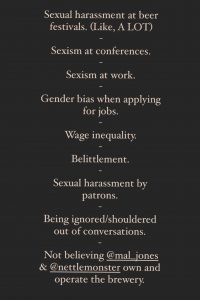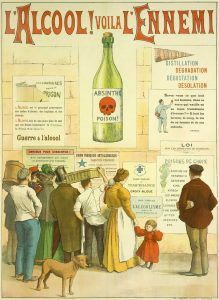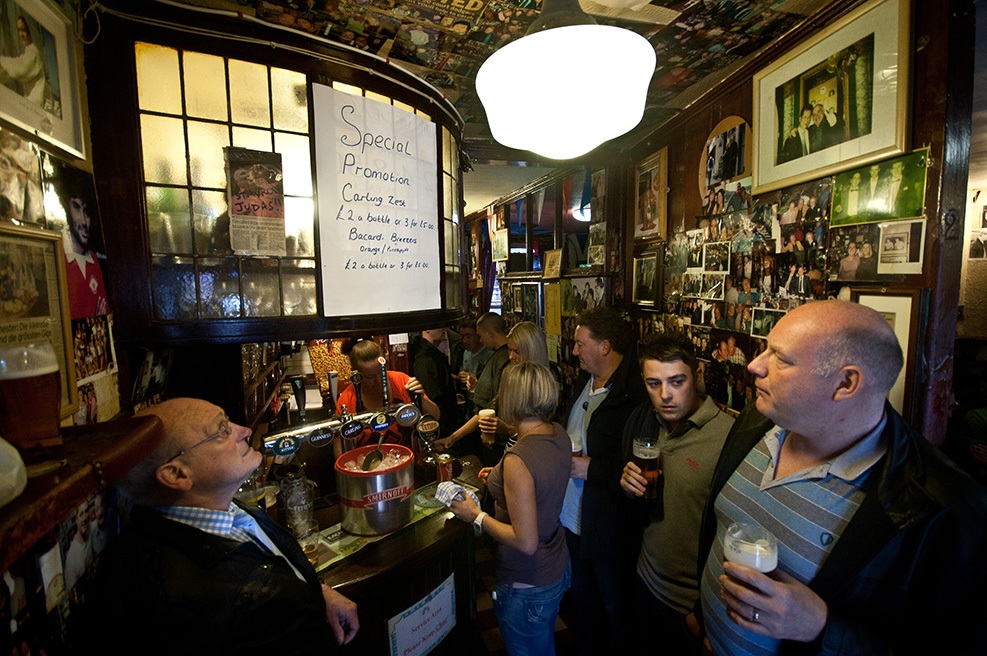I like this image above. It is a bit of an edit off a photo from Great Lakes Brewery off the north shore of Lake Ontario (as opposed to the one to the south of Lake Erie). Depth of field hit very nicely. Gran’s hand towels being put to good use. And clean lines every day. Best practice. Speaking of which, let’s see what else is worth noting in another week in the life of good beer and related stuff, shall we?
First off, Katie Mather wrote a very interesting piece of these times about a trip to sip natural wines in Paris which was as much about herself:
I ended up at Notre Dame every day I was in Paris. The resilient aura of a burnt-out cathedral was something I hadn’t been prepared for. I stared, making excuses to pass by, marvelling at the Medieval-like wooden supports bolstering the flying buttresses just like when they were new, wrong-footed by the stained glass rose window I had first seen in a Disney film, now blackened with soot. A dark emblem of survival—or perhaps a reminder of how close it has been to ruin, of being rescued, and still being rescued, and maintaining that iconic but now fragile facade. I was unwell, and I found a hand to grasp in the sight of this building. It seemed as tired as I was, of holding itself up, of being under so much of its own weight.
I am a bit interested in natural wine as I’ve known for a long time that I’m fairly sensitive to sulphite-based preservatives. This has been brought a bit into focus in the last few months as I am working on an intermittent diet that sees me weeding certain things out of my diet. Turns out I also have a problem with wheat and barley. Like a glass of red wine, good crusty bread triggers a histamine reaction. As does… beer. Weeping eyes. Inflammation. Drag. But manageable.
UPDATE: ghost tips over beer!
In his blog by email, Dave Infante took a very grim lesson from the Bell’s Brewery sale:
Remember early last decade? Selling out was anathema, and the U.S. craft brewing “movement” looked unstoppable. Now it’s starting to look insolvent. Sales are slowing; reports of workplace discrimination are up; a generation of new drinkers are reaching for hard seltzer and canned cocktails to power the party. In a 10 mere years, craft brewing’s rock-ribbed corporate antagonism has given way to self-imposed purity tests and fading relevance. In the same time, its product has morphed from zeitgeist-y leader to cheugy afterthought. Craft beer remains a product with a value proposition. But make no mistake: a dark night of the soul has fallen on its anti-commodity, independence-over-everything cultural dogma.
He’s probably right. Craft sucks. Right? Or is it “craft – doesn’t suck!” Can’t remember. Never mind – just remember who was calling craft “cheugy” back in May. The cool kids, that’s who.
Gary Gillman has been doing a fabulous job exploring eastern European brewing history with a focus on the role of Jewish culture. This week he wrote about hops:
Hop-growing in the former Austro-Hungarian province of Galicia was an established but relatively small-scale business up to World War I. Prior to 1850 one source, Penny Cyclopedia (1838), states “a few hops” were grown, a cottage industry at best. By 1879 hop-growing is on a more solid footing. The Journal of the Society of Arts was particularly approving of quality, stating at their best Galician hops could hardly be distinguished from classic Bohemian Saaz.
Speaking of things easterly, here’s your Belarus update: still finding myself filling the hours at home rather than sprinting out into the local upsurge in the delta, I came across a video blogger who rides the rails of eastern Europe looking for former Soviet things to talk about. In this episode, it’s about five beers from five cities in Belarus. Half seem to be gak. It is an interesting way to turn to Jeff’s thoughts (which we may have discussed before) about nationalism being the way to understand beer:
In the 44 years since Michael Jackson wrote The World Guide to Beer, people have become much more sophisticated in the way they understand and describe our favorite malty substance. The subject is incredibly complex, and over that span we have collected, classified, taxonomized, and shared information, refining what we know along the way. This effort has produced a shared (if disputed and endlessly debated) vocabulary and conceptual framework for discussing beer. For the most part, people have identified and developed the big concepts and we now focus on refining them. I was therefore surprised to discover a huge dynamic in beer that hasn’t gotten the classification/codification treatment: national tradition…
There is a lot in there to disagree with – that the subject is incredibly complex or that big concepts have been identified. Or that people have become more much more sophisticated. Consider this on that last point. But it is a reasonable additional way to look at a subject mired for a few decades in one fixed conceit – style. It is reasonable to have a number of ways to look at one thing to cross reference and improve understanding. But it is hampered by words like nation and culture that are greasy and malleable. Nations shift and cultures morph. Consider the political and cultural constructs just in Gary’s post above. And the concepts are prone to being coopted. Me, I am more of a globalist technology and trade story arc person myself. But that is another way of looking at things in addition to style and national tradition, isn’t it. No good comes of the unified theory approach except perhaps in physics. Maybe.
I raise all this by way of background as this week, Stan wasn’t entirely on board with the nationalist construct or at least the rendering of it that made the era of craft special. He wrote thusly by way of counter example:
Last week, during the virtual portion of the Master Brewers Conference, Greg Casey discussed “The Inspiring Histories & Legacies of American Lager Beer.” Casey, who worked for several of America’s largest brewing corporations before retiring in 2013, is writing a trilogy of books that focus on the period between the 1840s and 1940s. He points out that America gave the world “ice cold beer here!” Americans learned about brewing adjunct lagers from the Germans, but made them their own. They perfected chill proofing, allowing beers to be served crystal clear even when cold, changing the look of beer and the culture of drinking beer.
See, this is why we have all those facets of a topic. Like history. See, America did not give the world adjunct beer after receiving them from the Germans. The Germans handed it around themselves as part of their global mercantile and military empire from before the First World War. For example, Germany took over the “port city of Qingdao in north-eastern China in 1898, and ruled over it until 1914” and established Tsingtao beer. See also Argentina. As Boak and Bailey explained in Gambrinus Waltz, they also brought it to Britain. In Japan, a German trained Norwegian (who did admittedly touch down in the USA) founded what is now Kirin. In a bit of a twist, in the 1920s rice-based adjunct beer took off in Canada, to sent it the other way sending it south into the US black market during American prohibition.* Americans then took it with them where they went and often stayed. All of which leads me to think that while nationalism may not be the right unified theory, the paths of nations and the interacting influences upon them may as important as the history of technological advances if we are to understand why beer is what it is.
Speaking of beery culture, the local version got weird this week. I have to admit, I used to drop in at the place a few years back as it was handy to my ride home from work in the family car. Small pitcher of basic adjunct lager and a basket of onion rings was my order.
In a more sensible context, retiredmartin prodded me to read this post from the blog Prop Up The Bar which I liked for a number of reasons but especially the man on the street view:
As I arrived the gaffer was on the phone making a very angry call, his mood not improved by muggings here standing underneath the ‘table service only’ sign at the bar. During his phone call he threatened to “just shut the pub” which would have made this an epic pub ticking fail. Not sure what had upset him so much, but looking at my picture maybe he was on the phone to the company that looks after the shutters.
See also Lord Largis illustrating the “non-tick”:
I hadn’t eaten properly and as the bus approached the Hussey Arms I remembered how good the food is in there, but I’ve been spending too much on takeaways and meals of late and I’m trying to cut this cost down. I had an R Kelly lyric pop into my head. “My mind’s telling me no, but my body, my body’s telling me yes”. But as it was now dark and I wasn’t overly convinced that I knew where my first pub to visit was, my mind won and I remained on the bus.
I like that clarity of the vignette. Much uncertainty, conversely, surrounds a news release that informs us that two of Ontario and Canada’s best established craft brewers have done a form of a deal focusing on efficiencies in distribution. Trouble is… it seems to be more than that. As Jordan stated:
Getting increasingly angry about this entire set of messaging and the general level of competence. Insulting to everyone’s intelligence to dangle the shiny thing at exactly the same time as letting the majority of staff go.
Ottawa’s news source The Review had more on the background:
“I can confirm that layoffs took place today, but they are largely not related to the Steam Whistle announcement,” said Beau’s spokesperson Jen Beauchesne, in a Tuesday afternoon email to The Review in response to an inquiry about the layoffs and the Steamwhistle announcement. Most of temporary layoffs which occurred this week are because Beau’s is slowing down production, while the company does maintenance work on its lines and brewing tanks, said Beau’s co-founder and Chief Executive Officer (CEO), Steve Beauchesne. “We have been having some fermentation issues,” Beauchesne said. “We need to empty the tanks and do a deep clean.”
Questions have arisen but, look, the Beauchesnes are family brewers from a small town in far eastern Ontario and (a rarity) I happily call them friends. They are great fun folk who I’ve had over to the backyard and who’ve had me to their fests. The times, however, may not be kind and if the business changes coming are greater than they are in position to discuss today, I can only wish them and their community the best.
B.O.B.** of the Week: Mr B on a rather good brewery in his neighbourhood. The denial of standard B.O.B. context at the outset is an interesting variation on the brewery owner bio.
Finally: “Man driving 870 miles in world’s smallest car” – not about beer but, still, please send your 500 word essays as usual on how it is still like beer to the regular address to be entered in the context for our weekly prize of a photograph of a ten dollar bill.
That’s a lot. Busy week. For more, check out the updates from that same Boak and Bailey mostly every Saturday and from Stan now on a regular basis again every Monday, plus more with the weekly Beer Ladies Podcast, and at the weekly OCBG Podcast on Tuesday (where a parsing of press releases was featured this week accompanied by giggle, chortles and the mewing of cats) and sometimes on a Friday posts at The Fizz as well. There is a monthly sort of round up at The Glass. There is more from the DaftAboutCraft podcast, too. And the Beervana podcast. And sign up for Katie’s weekly newsletter, The Gulp, too. And check out the Atlantic Canada Beer Blog‘s weekly roundup. Plus follow the venerable Full Pint podcast. And Fermentation Radio with Emma Inch. The AfroBeerChick podcast as well! And also look at Brewsround and Cabin Fever. And Ben has his own podcast, Beer and Badword which may revive some day. And remember BeerEdge, too, and The Moon Under Water.
*See The King v. Carling Export Brewing & Malting Co. Ltd., [1930] S.C.R. 361 at page 373.
**“Was ist eine B.O.B.? Das is eine B.O.B.!!” Translation: Brauereibesitzerlangweiliglichbiografie.














 It was supposed to be fun. All fun. But now there is the reckoning. Not just in the sense of #Dryuary but #Skint-uary. #I-spent-all-I-had-uary. No wonder folk feel a pinch and stop splurging. Remember, though… pubs can be for
It was supposed to be fun. All fun. But now there is the reckoning. Not just in the sense of #Dryuary but #Skint-uary. #I-spent-all-I-had-uary. No wonder folk feel a pinch and stop splurging. Remember, though… pubs can be for 




